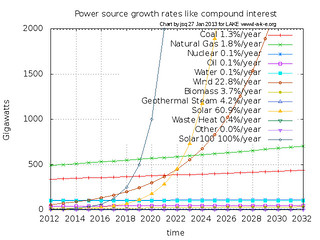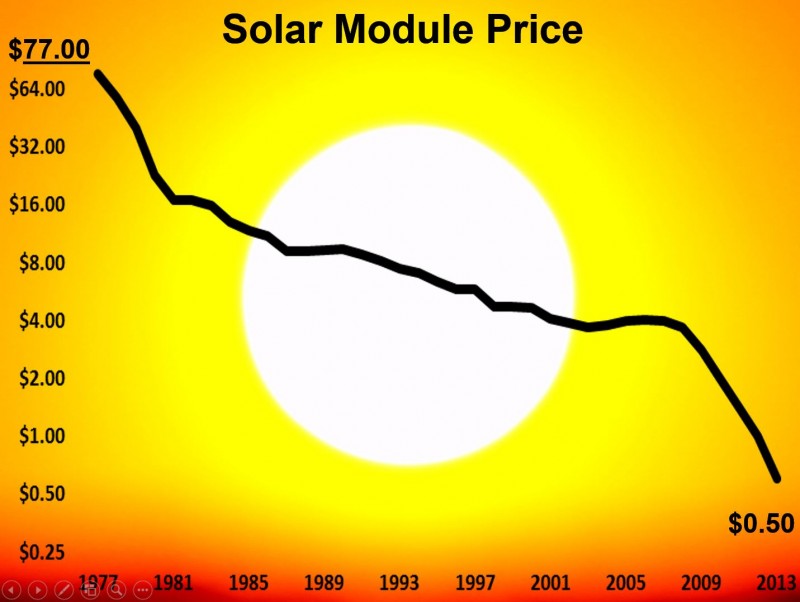More confirmation that solar power is winning so there’s no excuse for any new pipelines.
tl;dr: Moore’s Law is an analogy. As an analogy, it works. And progress is happening far faster than I projected in my ‘solar Moore’s Law’ piece of 2011.]
Ramez Naam, on his blog, April 2015, Is Moore’s Law Really a Fair Comparison for Solar?
[This is an update of a post I first wrote in March of 2011, responding to criticism of the analogy of Moore’s Law for solar power. Updating in April 2015, on the 50th Anniversary of Moore’s Law, in light of renewed conversation on this topic….
… actual progress in solar power module prices has been dramatically faster than I projected.
In the 2011 piece, the graphs project that in 2015, solar modules would cost just under $2 / watt. We’d reach 50 cents per watt in module price around 2030.
We have 50 cent per watt solar module prices today. Solar module prices are 15 years ahead of where those (at the time, optimistic) projections in 2011 placed them.
Say what you will about the analogy of Solar Moore’s Law — the numerical projections of price that I presented in 2011 were too conservative. Price reduction has happened far faster than the historical norm.
And yes, I know the mechanisms are not exactly the same as Moore’s Law for computer chips; that’s why it’s an analogy.
An analogy demonstrating what exponential growth can do, as I pointed out in 2012: computers, mobile phones, the Internet itself, and smart phones all deployed on exponential curves.
One year only a few had even heard of them. Ten years later everybody had them.
 And that ten years for solar power started in 2013, with the
predictions by former FERC Chair Jon Wellinghoff and me that
within a decade more U.S. electric energy will come from solar power
than any other source.
That’s by 2023.
And according to eia and FERC figures,
solar deployment is actually going faster than we predicted.
And that ten years for solar power started in 2013, with the
predictions by former FERC Chair Jon Wellinghoff and me that
within a decade more U.S. electric energy will come from solar power
than any other source.
That’s by 2023.
And according to eia and FERC figures,
solar deployment is actually going faster than we predicted.
Just like Ramez Naam observes that the prices driving that solar deployment are dropping faster than he predicted.
Solar power will win like the Internet did. Now that a governor who took campaign funds from six different pipeline companies has signed a solar financing bill passed unanimously by both houses of the most corruption-prone legislature, helping make that state, Georgia, the fastest-growing solar market in the country, while coal is crashing, and new pipelines are running into opposition everywhere, it’s becoming obvious to everyone that solar power will win. After all, fixing climate change is profitable, and solar power is the fastest way to get going on that path.
Not just solar powering the current electrical grid, either. Mark Z. Jacobson’s peer-reviewed Stanford research has laid out a plan for sun, wind, and water power for everything from cars to airplanes by 2050, with 25% by 2025, 80% by 2030, and 90% by 2035.
 There is no longer any excuse for building more 20th century pipelines.
Let’s stop Sabal Trail
and all its kin before they do any more damage.
There is no longer any excuse for building more 20th century pipelines.
Let’s stop Sabal Trail
and all its kin before they do any more damage.
Let’s go straight to cleaner, safer, faster, cheaper, sun, wind, and water power.
The sun is rising!
-jsq
Short Link:
